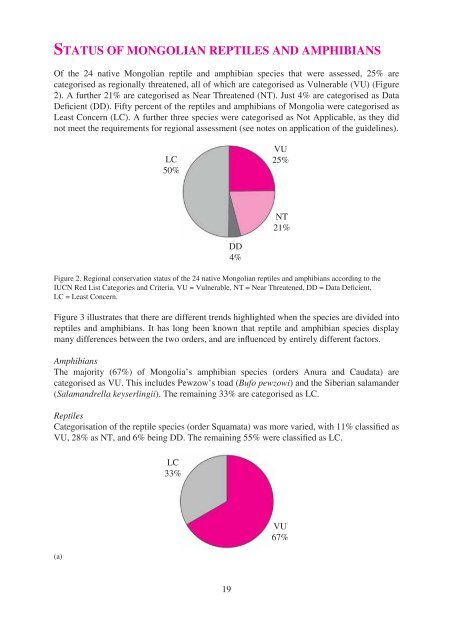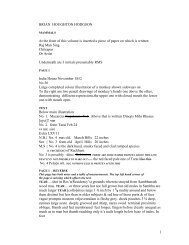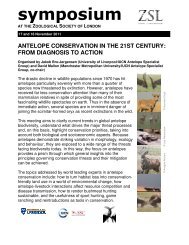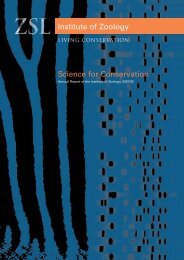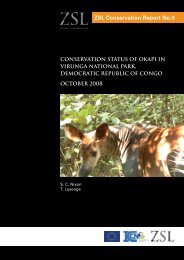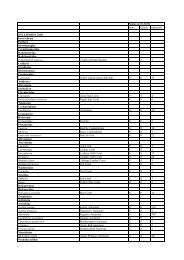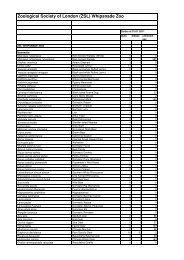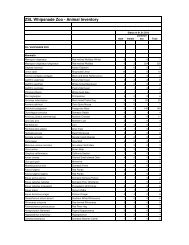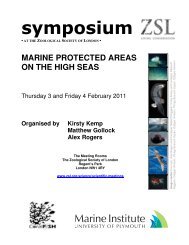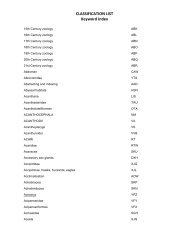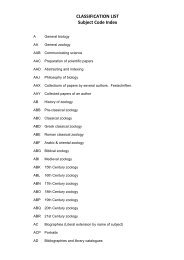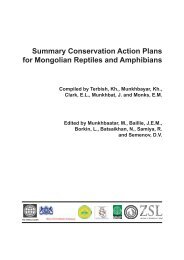Mongolian Red List of Reptiles and Amphibians - Web - Zoological ...
Mongolian Red List of Reptiles and Amphibians - Web - Zoological ...
Mongolian Red List of Reptiles and Amphibians - Web - Zoological ...
You also want an ePaper? Increase the reach of your titles
YUMPU automatically turns print PDFs into web optimized ePapers that Google loves.
STATUS OF MONGOLIAN REPTILES AND AMPHIBIANS<br />
Of the 24 native <strong>Mongolian</strong> reptile <strong>and</strong> amphibian species that were assessed, 25% are<br />
categorised as regionally threatened, all <strong>of</strong> which are categorised as Vulnerable (VU) (Figure<br />
2). A further 21% are categorised as Near Threatened (NT). Just 4% are categorised as Data<br />
Defi cient (DD). Fifty percent <strong>of</strong> the reptiles <strong>and</strong> amphibians <strong>of</strong> Mongolia were categorised as<br />
Least Concern (LC). A further three species were categorised as Not Applicable, as they did<br />
not meet the requirements for regional assessment (see notes on application <strong>of</strong> the guidelines).<br />
LC<br />
50%<br />
19<br />
DD<br />
4%<br />
VU<br />
25%<br />
NT<br />
21%<br />
Figure 2. Regional conservation status <strong>of</strong> the 24 native <strong>Mongolian</strong> reptiles <strong>and</strong> amphibians according to the<br />
IUCN <strong>Red</strong> <strong>List</strong> Categories <strong>and</strong> Criteria. VU = Vulnerable, NT = Near Threatened, DD = Data Defi cient,<br />
LC = Least Concern.<br />
Figure 3 illustrates that there are different trends highlighted when the species are divided into<br />
reptiles <strong>and</strong> amphibians. It has long been known that reptile <strong>and</strong> amphibian species display<br />
many differences between the two orders, <strong>and</strong> are infl uenced by entirely different factors.<br />
<strong>Amphibians</strong><br />
The majority (67%) <strong>of</strong> Mongolia’s amphibian species (orders Anura <strong>and</strong> Caudata) are<br />
categorised as VU. This includes Pewzow’s toad (Bufo pewzowi) <strong>and</strong> the Siberian salam<strong>and</strong>er<br />
(Salam<strong>and</strong>rella keyserlingii). The remaining 33% are categorised as LC.<br />
<strong>Reptiles</strong><br />
Categorisation <strong>of</strong> the reptile species (order Squamata) was more varied, with 11% classifi ed as<br />
VU, 28% as NT, <strong>and</strong> 6% being DD. The remaining 55% were classifi ed as LC.<br />
(a)<br />
LC<br />
33%<br />
VU<br />
67%


